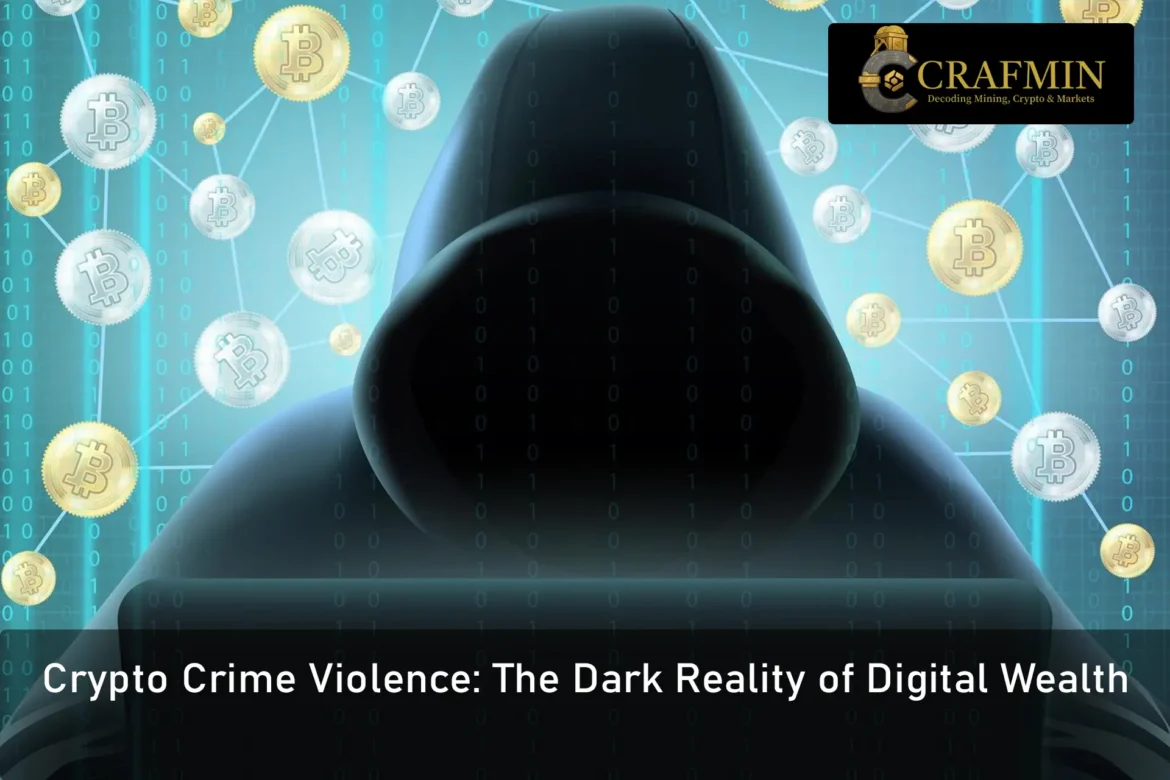Cryptocurrencies were designed to liberate finance—unshackling it from traditional systems and granting individuals unprecedented financial autonomy. But this freedom has a dark side. As digital assets surge in popularity and value, a sinister trend is emerging: crypto crime violence.
From Paris to New York, criminals are trading keyboards for crowbars, abandoning phishing emails in favour of physical violence. The digital gold rush is drawing blood. What was once a cybersecurity concern is now a full-blown real-world threat.

Crypto’s Dark Side: When Wealth Turns Violent ( Image Source: Digital Watch Observatory )
A Global Spike in Physical Crypto Attacks
The past year has seen a sharp increase in violent crimes targeting cryptocurrency holders. In Paris, a prominent tech entrepreneur deeply involved in crypto was abducted and tortured, with attackers demanding his private key. In New York, an Italian investor was held captive and waterboarded for access to his Bitcoin wallet. In Connecticut, an elderly couple was kidnapped, allegedly due to their son’s involvement in a massive digital heist.
These events aren’t isolated anomalies. They mark a terrifying escalation in how criminals are exploiting digital wealth. Crypto-related violence is no longer virtual—it’s brutal, personal, and real.

Global Rise in Violent Crypto-Related Attacks ( Image Source: Forbes )
Why Crypto Attracts Physical Violence
The appeal of cryptocurrency lies in its decentralised nature, anonymity, and independence from banks. But those same traits also make it dangerously attractive to criminals.
Unlike traditional financial accounts, crypto wallets are protected by a single private key. Whoever holds that key has full, irreversible control over the funds. And if criminals can’t hack it, they’ll force it out of you.
You don’t need to be a millionaire to be targeted. Investors, Web3 developers, and NFT collectors—anyone flaunting their digital success online—is at risk. The dark web is filled with forums where bad actors share strategies on how to stalk, isolate, and violently extract crypto credentials.
How Crypto Kidnappings Work: A Chilling Playbook
Most crypto extortion incidents follow a disturbingly methodical sequence:
- Selection: Criminals identify targets through social media, wallet activity, or public bragging.
- Monitoring: Victims are observed for days or weeks, with routines and weaknesses logged.
- Ambush: The attack unfolds—either a home invasion, staged accident, or abduction.
- Extraction: Victims are tortured or threatened to surrender wallet passwords or initiate transfers.
- Exit: Funds are instantly laundered using decentralised exchanges, privacy coins, or crypto mixers.
Victims often suffer lasting emotional trauma, and recovery of funds is nearly impossible. Law enforcement, often unequipped to handle the anonymous nature of blockchain transactions, struggles to investigate and prosecute.
New Crypto Crime Trends in 2025
Data from global cybercrime monitoring organisations shows a 62% rise in physically violent crypto crimes since early 2024. These aren’t random assaults—they’re premeditated operations involving international syndicates, military-grade tactics, and sophisticated surveillance.
This shift represents more than just a spike in crime—it signals a transformation. Cybersecurity experts now warn of a new era where digital wealth invites physical aggression, as bad actors move offline in pursuit of profit.
Overlooked Risks in Crypto Ownership
Many investors rely on cold wallets and hardware devices like Ledger or Trezor to protect their funds. While these tools defend against cyber hacks, they offer zero protection against coercion under duress.
Even the use of multi-signature (multi-sig) wallets—which require multiple parties to authorise transactions—can be compromised if just one participant is physically forced to comply.
Other underestimated risks include:
- In-person trading dangers: Meeting buyers or sellers for peer-to-peer exchanges can easily turn hostile.
- Cross-border travel: Carrying devices with large crypto holdings can attract attention at customs or airports.
- Social media exposure: Sharing personal achievements, luxury items, or travel updates can reveal more than intended.
In the crypto world, where privacy is paramount, even small slips can have dangerous consequences.
Real Stories That Shake the Industry
The stories coming out of 2025 are as harrowing as they are real:
- David Balland, a co-founder of crypto hardware firm Ledger, was abducted outside his home in Paris. Attackers severed part of his finger while filming the act to pressure him for access. He survived—but the trauma lingers.
- Michael Carturan, a known investor from Italy, was tortured for days in a luxury SoHo townhouse. Waterboarding, cigarette burns, and electric shocks were used to extract his Bitcoin credentials.
- The Danbury Abduction, involving a retired couple aged 71 and 69, saw them kidnapped from their Connecticut home. The motive? To coerce their son into revealing the whereabouts of stolen digital assets worth over $200 million.
Also Read: Why Privacy on Blockchain Is Vital as AI Advances
Each case underlines the unsettling truth: digital finance now carries physical consequences.
How to Protect Yourself from Crypto Crime Violence
You don’t need millions in crypto to become a target. If you own any digital assets, you must treat your personal safety as seriously as your password hygiene.

Protecting Yourself Against Crypto Crime Violence ( Image Source: Fortune )
Key safety strategies include:
- Don’t publicise holdings: Avoid sharing your crypto gains, wallet balances, or NFTs online—or even in casual conversations.
- Use offline storage wisely: Hide cold wallets securely. Don’t label them, and keep them inaccessible to visitors.
- Enable multi-signature access: Split control of your funds with trusted parties, reducing your single-point vulnerability.
- Create emergency protocols: Brief your family on procedures in case of extortion. Consider emergency wallet freezing services.
- Opt for professional platforms: Use secure, regulated exchanges instead of peer-to-peer trades when possible.
Safety is no longer optional—it’s essential.
Law Enforcement Is Falling Behind
The anonymous nature of crypto complicates investigations. Even when attackers are caught, tracing stolen assets is difficult. Tools like privacy coins (e.g., Monero), mixers (e.g., Tornado Cash), and decentralised exchanges make it easy for criminals to clean and hide their loot.
Moreover, crypto crimes are often international in scope. A victim in France might be attacked by a syndicate in Eastern Europe, with stolen coins passed through Asian mixers and cashed out in Latin America. Jurisdictional challenges cripple law enforcement.
Current laws lag far behind the technology, leaving both victims and agencies frustrated.
From Cybersecurity to Physical Security
The crypto community has long focused on digital security—strong passwords, cold wallets, hardware keys. But the threat vector has changed. Today, it’s not just hackers in dark rooms—it’s gangs on motorbikes, kidnappers in ski masks, and criminals with handguns.

From Digital Safeguards to Physical Protection ( Image Source: GRC Viewpoint )
This shift demands a broader, more comprehensive approach. Investors must now factor in physical, psychological, and familial security into their crypto strategy.
A Wake-Up Call for the Crypto Industry
Cryptocurrency has democratised finance and opened up powerful new opportunities. But it also demands personal accountability in ways traditional banking does not.
The recent surge in crypto crime violence is not fearmongering—it’s a call for smarter protection, discreet practices, and global awareness. Just as decentralised technology evolved rapidly, so too must our mindset about safety.
As we build towards Web3, decentralised finance, and tokenised everything, one fact remains: we’re still human. Vulnerable, emotional, and, in many cases, unprepared for the risks our digital lives carry into the real world.
Final Thoughts: Guard Your Wallet and Your Life
We often say, “not your keys, not your coins.” But in 2025, that’s only half the truth.
Now, it’s also: “guard your keys—or risk your life.”
Crypto is no longer just a tech or finance trend. It’s a socio-economic revolution. And like all revolutions, it has its martyrs and casualties. Whether you’re an investor, builder, or casual trader, the time for casual security is over.
Digital wealth has blurred the line between online and offline risk. Protect your assets, yes—but more importantly, protect yourself.

